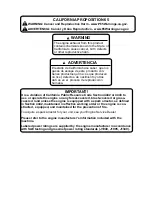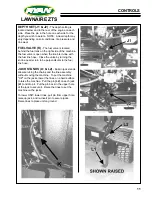
14
LAWNAIRE ZTS
PRE-OPERATION CHECK LIST
(OWNER’S RESPONSIBILITY)
___ Review and follow all safety rules and safety
decal instructions.
___ Check that all safety decals are installed and in
good condition. Replace if damaged.
___ Check to make sure all shields and guards are
properly installed and in good condition.
___ Check that all hardware is properly installed.
and secured.
___ Check that equipment is properly and securely
attached to power unit.
___ Check to be sure engine is free of dirt and
debris. Pay particular attention to the cooling
fins, governor parts and muffler. Clean air
intake screen. Check air cleaner; service if
necessary.
___ Never allow riders.
___ Inspect area and remove stones, branches or
other hard objects that might affect aeration,
cause injury or damage.
___ Clean area around oil fill dipstick. Remove
dipstick and check to be sure oil is in operating
range (between marks on dipstick). Add oil if
necessary but
Do Not Overfill
. Install dipstick
assembly firmly until cap bottoms out on tube.
Dipstick assembly must always be secured into
fill tube when engine is running.
___ Check all lubrication points and grease as
instructed in manual.
___ Check hydrostatic fluid level. Check to be sure
cooling fins on hydrostat are clean.
___ Perform a functional check of the safety
interlock system each time you operate the
unit.
PRE-OPERATION CHECK LIST
SERIOUS INJURY OR DEATH MAY RESULT
FROM MACHINE ROLLOVER
•
DO NOT OPERATE MACHINE ON STEEP
SLOPES OR NEAR DROPOFFS
•
AVOID SHARP AND/OR QUICK TURNS
ROLLOVER MAY CAUSE PERMANENT INJURY OR DEATH.
•
SUDDEN STARTS OR TURNS ON RAMPS OR SLOPES CAN CAUSE OVERTURN.
•
USE GREATER CARE ON RAMPS AND AS THE SLOPE INCREASES.
Use caution when making turns.
Slow down before making sharp turns to help maintain control and to
prevent torn turf from skidding or spinning tires. To help prevent turf damage, keep both drive tires moving
whenever a turn is made.
TIP:
The best way to make a sharp "zero" turn is to come to a stop, get the machine moving in reverse with
both drive wheels and then powering the machine around with the outside wheel. This technique keeps the
drive tires turning and results in less turf damage.
















































